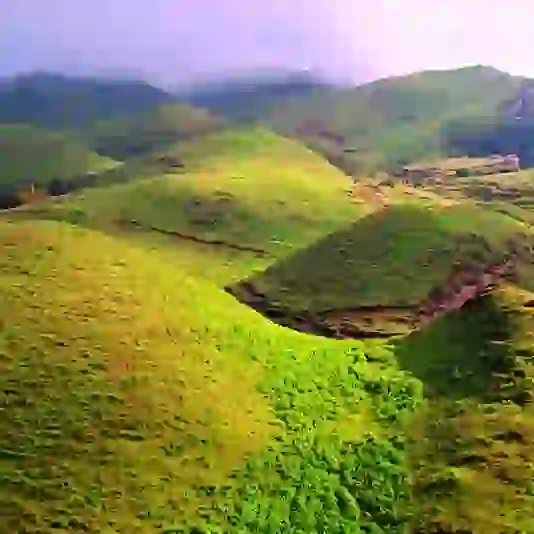Hidden within the lap of the great Himalayas lies the roof of the world, Nepal.' India and China encircle it; India from the east, south, and west and by China from the north.
It occupies a locality of 147,181 sq. Km. which includes 0.03% of the overall expanse of the planet and 0.3% of the total area of Asia. Although it covers such a small landmass, it consists of an extensive range of topography. Also, these diverse topographies houses some of the rarest and endangered species of flora and fauna in the world.
The varying altitude contributes to altering the climatic condition in various parts of the county, which in turn is responsible for the richness of flora and fauna. The climate contributes to the nurturing of different animals, some rare species too. However, because of their overhunting, poaching, destruction of habitat, climate change, they are at risk of extinction.
List of Top 24 Endangered Animals Species in Nepal
Because of human-made and natural problems, many rare animals face the risk of extinction. The grand showcase of lucrative flora and fauna has attracted the attention of hunters and poachers for a long time. Due to high-value products, the animals are primarily being targeted.
Teeth, tusks, skins of the animals are used in ornaments, luxury clothing. The bones of the animals are also utilized in the synthesis of ancient Chinese and Japanese drugs. Despite being banned from production, the demand for these animal products encourages these poachers to poach these rare animals.
According to a survey carried out in 2013, there are 198 Tigers in Nepal at present; this is an increment of 63% in the Tiger population compared to 2009. This example alone verifies how severe the issue is.
Along with the poaching and hunting, the rapid trend of industrialization and urbanization has severely disturbed the natural habitat of some species of animals. In the 1970s, Gharials, a species of crocodile became almost extinct due to excessive river pollution and dying of fishes.
The intervention of humans has exposed them to the risk of endangerment and even extinction! Some of the endangered animals of Nepal are listed below:
List Of Endangered Animals of Nepal
1. Red Panda ( Ailurus fulgens )
Red pandas are found in the western forests of Nepal and the southwestern mountain slopes of China. Weighing up to 6 kg, they can grow to about 50 – 63 cm in length. They have a signature reddish-brown, thick fur, and have a raccoon-like appearance.

Adorable Red Panda in Nature
The thick fur coat protects against the harsh cold; the fur is sought after by poachers because of its high value. The red panda is endangered mostly due to loss of habitat caused by Deforestation. It usually lives in thick bamboo forests, which are being cleared for land, fuel, and timber.
2. Snow Leopard ( Uncia uncia )
The snow leopards are distributed mostly in the mountainous regions of Mustang, Mugu, Dolpo, and Humla. Characterized by its smoky grey fur coat covered by dark grey spots, the snow leopard weighs about 35-55 kg and grows up to 1.8 – 2.3m.

Snow Leopard in its Habitat
They have long bushy tails with significantly large paws to aid in climbing mountains. Along with the effects of global warming and the interference of human activities, snow leopards have been gravely affected.
The pelts and bones of the snow leopard are used for making medicines and thus are poached.
3. Bengal Tiger ( Panthera tigris tigris )
Bengal Tigers are known to be the most ferocious tigers among all. Native to the Indian sub-continent, they are one of the largest big cats of Asia. They weigh about 250 kg and can measure up to almost 3m in length.

Majestic Bengal Tiger in Jungle
The Tigers have unique stripe patterns on their golden-brown skin, and the very character almost led to its extinction due to over poaching and hunting.
There are about 235 Tigers in Nepal according to the census of 2018. They face a significant threat of being extinct in the wild and are hence one of the most endangered animals in Nepal.
4. One-horned Rhinoceros ( Rhinoceros unicornis )
Known all around by its characteristic one horn, this is one exotic beast. Weighing up to 2-2.5 metric tons and growing to near 3.7-3.8m, this animal is exclusive to the Indian sub-continent. They usually prefer a solitary life but also move in herds sometimes.

One-Horned Rhinoceros in Natural Habitat
The one-horned rhino is mostly hunted for its prized horn which is made up of Keratin. Found only in India and Nepal, many efforts have been made to protect these rare animals.
5. Himalayan Musk Deer ( Moschus leucogaster )
The Himalayan Musk deer measures up to 1 m and weighs about 11-18 kg. They are found in the Himalayan regions of Nepal, India, Pakistan, and China. Both male and female musk deer have well-developed upper canine teeth which grow out in a fang-like manner.

Graceful Himalayan Musk Deer
The Musk deer are high in demand because of their scent glands. The poachers poach them as the glands are considered to be more valuable than gold. The scent gland of the musk deer is used to make perfumes and oriental medicines.
6. Ganges River Dolphin ( Platanista gangetica )
Ganges River Dolphins are one of the 4 freshwater dolphins. They live in the Ganges and Brahmaputra River and their tributaries which are located in India, Nepal, and Bangladesh. These dolphins are greyish brown in colour and grow to the lengths of about 2.67m.

Elegant Ganges River Dolphin
The Ganges River dolphins lack an eye lens, and hence, it is also called “the blind dolphin." These dolphins live in one of the most densely populated regions in the world and are threatened by loss of habitat. Construction of dams, irrigation projects, and river pollution contribute to the destruction of the homes of these mammals.
7. Swamp Deer ( Cervus duvauceli )
The swamp deer is also known as "Barasingha". They move in massive herds and sometimes even combine herds to make a single herd of about 1000 deer. The male stag weighs about 170-280 kg while the females weigh about 140 kg.

Graceful Swamp Deer Herd
They can be found in the Suklaphanta wildlife reserve. They are strict grazers and depend upon grasslands for food. Because of the destruction of grasslands for land and food for cattle, these deer face extinction.
8. Asiatic Elephant ( Elephas maximus )
The Asiatic elephant is one of the largest land mammals. They weigh around 2.25 – 5.5 tons and live up to 60 years. The elephants have an elongated nose which is called a trunk; it is used for picking objects and moving stuff. The tusk is the most significant feature of an elephant.

Majestic Asiatic Elephant Roaming
The poachers aim for these tusks as elephant ivory is sold at very high prices in the black market. As a measure for protecting these animals, the government has created "Hattisars" which are camps for domesticated elephants. The Hattisars also survey the elephants and provide overall care for them.
9. Four-horned Antelope ( Tetracerus quadricornis )
The four-horned antelope are found in India and Nepal. They grow to a length of 1.1m and weigh around 22 kg. They have yellowish-brown or reddish fur coats, and only males have horns.

Four-Horned Antelope in the Wild
Two pairs of horns are present, and among them, the anterior pair is always smaller, and the posterior pair are the bigger ones. These animals remain on the endangered list because of the destruction of their habitation.
They thrive in the forest areas which are being cleared for land, and the grasslands are grazed by livestock. They are also hunted for food and their horns.
10. Black Buck ( Antelope cervicapra )
Blackbucks are found in India, Nepal, and Pakistan. They stand about 80cm tall and weigh about 33 kg. They live in herd comprising of only one dominant male and other females; the younger males stay away from, the older, dominant male.

Graceful Black Buck in Nature
The males are in black, hence the name. They graze in the open grasslands. They are endangered because of excessive hunting and destruction of their homes.
11. Pangolin
Pangolins are also commonly called “Salak” in Nepal. They are small insectivores with scale-covered backs. They curl up into a ball when they are threatened. These animals are also known as living fossils because they have been around for over 80 million years.
They are sought after because of their precious scales. Their scales are used for making oriental medicines in China. Pangolins are the most trafficked mammal in the world, with about 20% of the illegal wildlife trade accounted for Pangolins. Here, two species of Pangolins are present, and both of them are endangered

Rare Pangolin in Natural Habitat
Indian Pangolin (Manis crassicaudata)
Chinese Pangolin (Manis pentadactyla)
12. Assamese Monkey ( Macaca assamensis )
The Assamese Monkey (or also known as the Assam macaque) is listed in the' IUCN's near the threatened list. They live for 31 years and grow up to lengths of 73.5cm.

Assamese Monkey in Dense Forest
This species is unique to Nepal and is even believed to be a separate species as a whole. The Assamese monkeys are found in the tropical and sub-tropical forests of Nepal.
They are endangered because of loss of habitat and illegal hunting. The Nomads of Nepal, "Raute" also hunt and eat these monkeys plus as they invade crops in the fields, they are deliberately killed by the locals too.
13. Grey Wolf ( Canis lupus lupus )
The grey wolves are found in the Upper Mustang, Dolpa and Manaslu. Their grey fur coats recognize them with a long, thin, dog-like legs. They mostly prey on the Blue Sheep, Tibetan gazelle, etc., but are also known to prey on livestock and people.

Grey Wolf in the Wilderness
The grey fur fetches a good amount of money for hunters and poachers, and as they attack livestock, the locals also hunt them down. They are placed in the least concerned category in the world, but in Nepal, they are critically endangered.
14. Brown Bear ( Ursus arctos )
They are also commonly called grizzly bears, but in Nepal, it is called "rato valu." They are the largest species of bear found in the country. They grow up to a height of 1.4 to 2.8 m and weigh around 180kg.

Brown Bear Roaming Wild
They are mostly found within the Annapurna Conservation Area and are critically endangered here. They are primarily hunted for their reddish-brown fur coats. Another main reason is habitat loss because of clearing forests. Human and bear interactions have become quite common at present.
15. Spotted Linsang ( Prionodon particular )
The spotted linsang is a small, arboreal, weasel-like carnivorous mammal found throughout Southeast Asia. They are recognized by their low lung bodies, short limbs, long neck and yellowish fur with black spots and a ringed tail.

Spotted Linsang in Forest Habitat
They weigh about 0.45kg and have a height of 5.5 inches. This animal also faces endangerment in Nepal, although it is quite common throughout Southeast Asia. Habitat loss and poaching for its fur coat are the main reasons behind its endangerment.
16. Striped Hyena ( Hyaena hyaena )
Striped Hyena or also known as "Hundar", is found in the terai of Nepal. Their distinctive back stripes separate them from their African cousins, the Striped Hyena. They weigh about 22- 55kg and grow up to lengths of 130cm.

Striped Hyena in Its Habitat
They mostly live in grassland areas and prey on chital and hog deer. The locals also believe them to attack livestock and are therefore persecuted by poisoning food. To this species, humans have been a significant threat to their existence.
17. Leopard Cat ( Prionailurus Bengalensis )
The leopard cats reside in the subtropical regions of Nepal. They weigh about 5.8 kg and grow up to the length of 31cm. They are included in the vulnerable category.

Leopard Cat in the Wild
As they are agile and hunt birds, they are also called “Chari bagh” in Nepalese. They are usually persecuted by the locals as poultry pests and poachers also hunt for its teeth and pelt. Loss of habitat is also one of the reasons for the decreasing numbers of this species.
18. Clouded Leopard ( Neofelis Nebulosa )
Clouded leopards can weigh up to 23 kg and can grow to lengths of 94 cm from head to tail. This species was thought to be extinct in Nepal in the late 1860s but was spotted again in 1987.

Elegant Clouded Leopard in Jungle
The number of clouded leopards is meagre. The number is estimated to be below 100 and are threatened by illegal hunting and poaching. The pelts and teeth of the leopard are considered useful in making oriental medicines.
19. Himalayan lynx ( Lynx lynx isabellinus )
The Himalayan Lyn is commonly found in the Northern, Central, and Eastern Europe, Central Asia, China, and the Himalayas. In Nepal is can be found in the mountain regions.

Majestic Himalayan Lynx in Wilderness
They can measure up to 130cm in length and weigh up to 30kg. It is a medium-sized cat with thick furry paws, short tail and has little tufts of hairs above its ears. Humans mostly threaten lynxes than other natural predators. Locals kill them as Lynxes are said to prey on livestock.
20. Gaur Bison ( Bos gaurus )
The Gaur Bison is regarded as the largest of the wild cattle. It is commonly known as the Indian Bison. Standing at around 2m tall, it has a head and body length of about 250 to 330 cm and weighs over 1000kg!

Gaur Bison Roaming Serene Landscape
In Nepal, they are mostly found in the Chitwan National park and Parsa National park. Their numbers are said to be about 350 in Nepal according to the 2008 census. Deforestation and overgrazing of cattle have led to the endangerment of this species.
21. Wild Yak ( Bos mutus )
The Wild yaks live in the Himalayan regions, the alpine grasslands, and cold deserts. They are mostly found in Central Asia, China, Tibet, and Nepal. They are recognized by their distinct long, black, shaggy fur coat with a bushy tail. They are about 2.2m tall and weigh over 1000kg.

Majestic Wild Yak in Nature
Wild Yaks face competition from domestic cattle for food; hence, their numbers are declining at present. Plus the locals are also believed to hunt for Wild Yaks as a source of food.
22. Wild Water Buffalo ( Bubalus arnee )
The wild water Buffalo is native to Southeast Asia. It is commonly called "Arna" in Nepal. The longhorns of this large bovine are intimidating. It is found in the wetlands and grasslands of India, Nepal, Bhutan, Thailand, and Cambodia.

Wild Water Buffalo Grazing Peacefully
In Nepal, they are mostly found in the Koshi Tappu Wildlife Reserve. Similar to the wild yaks, the water buffalo also need to compete against the livestock for food. Moreover, because of the drying up of wetlands, Deforestation, and natural calamities, their habitat is getting destroyed. Also, the diseases transmitted from livestock has decreased their numbers significantly.
23. Great Tibetan Sheep ( Ovis ammon )
Great Tibetan Sheep, or also known as Argali, is found in the high lands of Central Asia. It is the second-largest Sheep species, grows up to 200 cm long. The females are called a ewe, which weighs about 100kg, and the males are called a ram, weighing about 328 kg.

Great Tibetan Sheep in Mountains
These animals face problems in their environment because of the changing climates. Overgrazing, Deforestation, and transmission of diseases from livestock have also affected them at present.
24. Hispid Hare
The Hispid hare is one of the rarest animals in the world. It was declared endangered by the IUCN in 1986. The Hispid hare has a dark brown coat with a whitish belly. They are about 18.7 inches long and weigh around 2.5 kg
Hispid Hare in Grassland Habitat
They have been spotted in the grasslands of India, Bangladesh, and Nepal. Hispid hare has been recently discovered in new parts; the Chitwan National park. The hares face extinction due to the destruction of their habitat.
Some of The Ways To Conserve Endangered Animals
Endangerment and extinction of animals can cause some severe disruption in the ecosystem of the area. The disturbance in the natural order would mean a negative impact on the environment, which indirectly affects us all.
Some measures To Protect Endangered Animals
- Ban on Illegal hunting and poaching
Killing animals for obtaining their precious parts is illegal. This not only affects the numbers of animals but also hampers the integrity of the country and society. Turning a blind eye to such perpetrators would only encourage hunting and poaching even more!
Development of strict rules and policies should help with this cause. Illegal hunting and poaching are heinous crimes and must be treated as such.
- Decrease Effects of Human Activities
Interaction of the modern human world with nature has not been that pleasant. Human activities have contributed a lot to the disruption of ecosystems in various regions of the world. Urbanization and industrialization affect the surrounding environment of the animals so these activities should be carried out away from the animal habitats.
- Conservation of Habitat
Animals require a specific condition to survive and multiply; these conditions are found in their natural habitat. They thrive in their natural condition if left untouched, so to protect these animals, their habitats must be protected first. With the effort of the government and the locals, the effects of human activities and natural calamities can be minimized to help in the conservation.
- Awareness Campaigns
Conscious and aware citizens mean a better and fulfilled nation. Public awareness campaigns can bring a massive difference in the conservation of these endangered animals.
Awareness about the endangerment, restricted areas, conservation areas, effects of human activities can help people understand much better and cooperate with the measures carried out for the conservation.
- Public Participation
Not just awareness, the involvement of the citizens is also extremely crucial for the success of this plan. Locals of the area can play a vital role in protecting these animals as they are the one interacting with them the most.
Measures to help increase the numbers or removal of risks to the animals can be carried out by the locals (under proper supervision) to aid in the conservation.
So, that is all for the list of Endangered Animals of Nepal and ways to protect them. As we gain more information and insight into the status of these rare animals, we must always remember not to interfere with their natural habitat.
Some plants develop in specific places thanks to the nourishing environment and earth. Similarly, some species of animals in Nepal are solely found in areas appropriate for them. We must make an effort to let them thrive in their natural environment and admire them as such.















